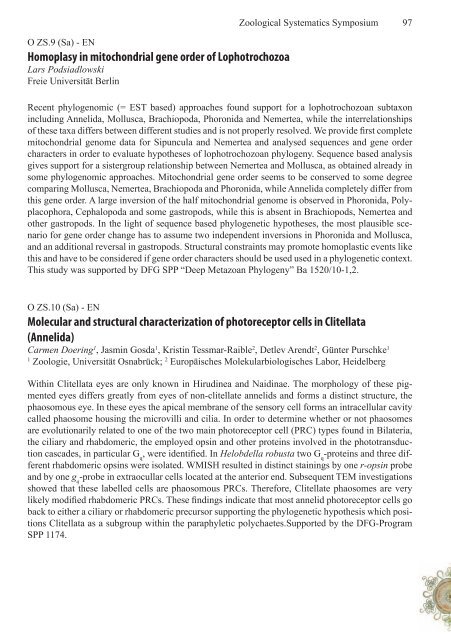Abstracts - Deutsche Zoologische Gesellschaft
Abstracts - Deutsche Zoologische Gesellschaft
Abstracts - Deutsche Zoologische Gesellschaft
You also want an ePaper? Increase the reach of your titles
YUMPU automatically turns print PDFs into web optimized ePapers that Google loves.
O ZS.9 (Sa) - ENHomoplasy in mitochondrial gene order of LophotrochozoaLars PodsiadlowskiFreie Universität BerlinZoological Systematics Symposium 97Recent phylogenomic (= EST based) approaches found support for a lophotrochozoan subtaxonincluding Annelida, Mollusca, Brachiopoda, Phoronida and Nemertea, while the interrelationshipsof these taxa differs between different studies and is not properly resolved. We provide first completemitochondrial genome data for Sipuncula and Nemertea and analysed sequences and gene ordercharacters in order to evaluate hypotheses of lophotrochozoan phylogeny. Sequence based analysisgives support for a sistergroup relationship between Nemertea and Mollusca, as obtained already insome phylogenomic approaches. Mitochondrial gene order seems to be conserved to some degreecomparing Mollusca, Nemertea, Brachiopoda and Phoronida, while Annelida completely differ fromthis gene order. A large inversion of the half mitochondrial genome is observed in Phoronida, Polyplacophora,Cephalopoda and some gastropods, while this is absent in Brachiopods, Nemertea andother gastropods. In the light of sequence based phylogenetic hypotheses, the most plausible scenariofor gene order change has to assume two independent inversions in Phoronida and Mollusca,and an additional reversal in gastropods. Structural constraints may promote homoplastic events likethis and have to be considered if gene order characters should be used used in a phylogenetic context.This study was supported by DFG SPP “Deep Metazoan Phylogeny” Ba 1520/10-1,2.O ZS.10 (Sa) - ENMolecular and structural characterization of photoreceptor cells in Clitellata(Annelida)Carmen Doering 1 , Jasmin Gosda 1 , Kristin Tessmar-Raible 2 , Detlev Arendt 2 , Günter Purschke 11Zoologie, Universität Osnabrück; 2 Europäisches Molekularbiologisches Labor, HeidelbergWithin Clitellata eyes are only known in Hirudinea and Naidinae. The morphology of these pigmentedeyes differs greatly from eyes of non-clitellate annelids and forms a distinct structure, thephaosomous eye. In these eyes the apical membrane of the sensory cell forms an intracellular cavitycalled phaosome housing the microvilli and cilia. In order to determine whether or not phaosomesare evolutionarily related to one of the two main photoreceptor cell (PRC) types found in Bilateria,the ciliary and rhabdomeric, the employed opsin and other proteins involved in the phototransductioncascades, in particular G q, were identified. In Helobdella robusta two G q-proteins and three differentrhabdomeric opsins were isolated. WMISH resulted in distinct stainings by one r-opsin probeand by one g q-probe in extraocullar cells located at the anterior end. Subsequent TEM investigationsshowed that these labelled cells are phaosomous PRCs. Therefore, Clitellate phaosomes are verylikely modified rhabdomeric PRCs. These findings indicate that most annelid photoreceptor cells goback to either a ciliary or rhabdomeric precursor supporting the phylogenetic hypothesis which positionsClitellata as a subgroup within the paraphyletic polychaetes.Supported by the DFG-ProgramSPP 1174.

















